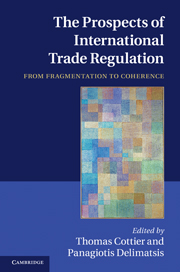Book contents
- Frontmatter
- Contents
- List of figures
- List of tables
- Contributors
- Preface and acknowledgements
- Table of cases
- List of abbreviations
- Introduction: fragmentation and coherence in international trade regulation: analysis and conceptual foundations
- PART I Constitutional issues in international trade regulation
- PART II Reforming specific areas of trade regulation
- PART III ‘Trade and…’ linkages
- 8 A call for a WTO ministerial decision on trade and human rights
- 9 The protection and promotion of cultural diversity in a digital networked environment: mapping possible advances towards coherence
- 10 Development and stability in the nexus between trade and finance
- 11 The regulatory framework of international investment: the challenge of fragmentation in a changing world economy
- 12 Low-income countries and commodity price volatility
- Index
- References
12 - Low-income countries and commodity price volatility
from PART III - ‘Trade and…’ linkages
Published online by Cambridge University Press: 26 April 2011
- Frontmatter
- Contents
- List of figures
- List of tables
- Contributors
- Preface and acknowledgements
- Table of cases
- List of abbreviations
- Introduction: fragmentation and coherence in international trade regulation: analysis and conceptual foundations
- PART I Constitutional issues in international trade regulation
- PART II Reforming specific areas of trade regulation
- PART III ‘Trade and…’ linkages
- 8 A call for a WTO ministerial decision on trade and human rights
- 9 The protection and promotion of cultural diversity in a digital networked environment: mapping possible advances towards coherence
- 10 Development and stability in the nexus between trade and finance
- 11 The regulatory framework of international investment: the challenge of fragmentation in a changing world economy
- 12 Low-income countries and commodity price volatility
- Index
- References
Summary
KEY MESSAGES
∙ Low-income countries (LICs) are highly vulnerable to fluctuations in commodity prices. Excessive price volatility complicates macroeconomic management and can worsen long-run growth and development prospects.
∙ Financial speculation has caused price volatility in the international markets beyond what could possibly be explained on the grounds of fundamentals of supply and demand alone.
∙ Field studies of the cotton and coffee sectors in Tanzania and Uganda show that sound market structures and institutions need to be in place for producers, households and villages to cope with price shocks.
∙ The case study of copper in Zambia highlights the extraordinary difficulties LICs encounter in devising appropriate monetary and exchange rate policies over the commodity price cycle.
∙ Overall, we reach the conclusion that LICs' vulnerability to commodity price volatility requires international support targeting supply-side constraints, together with the establishment of a financing scheme compensating the effects of price shocks. Of course, it is crucial that international support be premised on the pursuance of sound governance and macroeconomic policy at the domestic level.
∙ In support of our argument for an increased role of foreign aid as a temporary device to counter excessive price volatility, we outline the main features of our proposal for such a compensatory financing mechanism and show, in the case of Uganda, that its application would be highly effective and relatively cost-efficient in achieving the goal of increased protection from price volatility and trade shocks more in general.
- Type
- Chapter
- Information
- The Prospects of International Trade RegulationFrom Fragmentation to Coherence, pp. 452 - 482Publisher: Cambridge University PressPrint publication year: 2011
References
- 1
- Cited by



